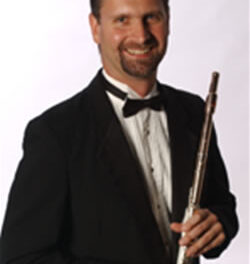Alexander Ezerman is the new associate professor of cello in The School of Music at the University of North Carolina Greensboro. A fine sampling of his musical skills was reviewed in Kelly Burke’s October 1, 2008 clarinet recital. Cello players run four generations deep in Ezerman’s family and have included two former principals of the Philadelphia Orchestra. His own biography is filled with impressive prizes, international concertizing, and a strong dedication to both chamber music and as an advocate for new music.
While the audience in the warm acoustics of the Recital Hall was modest in size, word-of-mouth had led to a larger than expected turnout and a shortage of programs. Ezerman’s imaginative program consisted of works as demanding of the keyboard as the cello, which was in the ever-capable hands of Ināra Zandmane.
While the first cello sonata of Felix Mendelssohn (1809-1847) has much of the quality of a salon piece, his Sonata No. 2 in D Major, Op. 58 (1843) is clearly a work for the concert hall. The first of its four movements is launched with both instruments in full flight and the continuously exciting music is a blend of ever-surging cello melody which Benjamin Folkman, in program notes to James Kreger’s Discover CD, has described as “blizzards of gossamer piano arpeggiation.” With its cello pizzicatos and crisp piano articulation, the composer’s fairy world seems to hover over the Allegretto scherzando. The deep romanticism of the adagio is followed by an exuberant and fast finale. Ezerman produced a full, rich, and resonant cello tone with spot on intonation. His bowing was extraordinarily clear and clean. He produced a broad palette of color and a finely graduated sense of dynamic expression. Zandmane played with the piano lid fully raised but had such perfect control of its dynamics so that she never covered the cello line. Her playing was the perfect foil to Ezerman .
Samuel Barber (1910-1981) was 22 years old when he composed his Cello Sonata, Op. 6 (1932) at the end of a summer walking tour of Italy with his to-be-long time companion, composer Gian Carlo Menotti. The three movement work is one of the most elusive works in the repertoire, both in performance and on recordings. An agitated, climbing theme opens the piece and is followed by a strongly contrasting lyrical second theme. If phrased correctly, this captures Barber’s unique mood of chimerical bitter sweetness. It is similar to the mature Brahms but distinctly Barber. The second movement combines the traditional “slow” and “scherzo” movements. Song-like cello lines are set against a playful presto. The turbulent finale ends with the return of the stormy opening theme of the first movement. Ezerman and Zandmane came closer than most in conveying this quixotic work. I would have preferred a little more “heart” in the first movement’s lyrical second theme but it is too easy to slip over into exaggeration.
Elliot Carter (b. 1908) is one hundred years old this season and is still going strong as a composer! His Cello Sonata (1948) was composed when he was just starting to discover his own unique voice and mastery. I attended the July 9, 2008 Eastern Music Festival performance of this work by cellist Matt Haimovitz reviewed by CVNC. This, along with listening to the Arabesque recording of the work by Joel Krosnick and Gilbert Kalish, helped me to appreciate the greatness of this pivotal early work and the terrific performance of it given by Ezerman and Zandmane. Ezerman encapsulated Carter’s achievement in a brief comment from the stage. He said Carter was exploring two qualities of time. In the first of the four movements the piano presents strict time, almost “tick-tock,” while the cello presents subjective time with its long, flowing lyrical phrases or agitated, rushing notes. By the end of final movement, the roles have been reversed. This superimposition of different times is a foretaste of Carter’s more complex layering of “musics” in his mature pieces. Ezerman and Zandmane played the socks off the sonata. After their traversal of the fast second movement, I wondered why it was frequently heard as an encore piece. A Carter piece as an encore! Performances like theirs ought to go far to make the sonata stand with the Prokofiev and Shostakovich as standard twentieth century repertoire pieces for cello and piano. Bravo!












